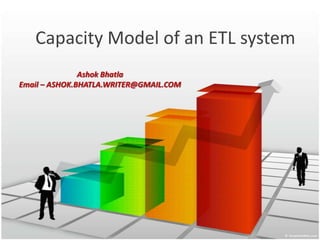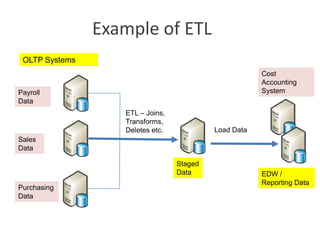Capacity Management of an ETL System
- 1. Capacity Model of an ETL system Ashok Bhatla Email – [email protected]
- 2. What is Business Intelligence? Business Intelligence (BI) is a combination of tools, processes and software which help a company to transform data into actionable knowledge, thereby allowing them to take faster and informed decisions in order to achieve their strategic goals. It’s all about providing right information to the management at the right time with the lowest possible cost. As we are drowning in data, but starving for knowledge, Business Intelligence has become the No. 1 priority for IT Managers today.
- 3. What is ETL? ETL stands for Extract, Transform and Load. A transactional system is meant to be a high performance system so that users can get their work faster. Running some reports from a Transactional system makes it slower. Therefore, the concept of ETL gained popularity. In computing, Extract, Transform, and Load (ETL) refers to a process in database usage which involves the following steps Extracts data from outside sources. Transforms it to fit operational needs, which can include joining/reformatting some tables. Loads it into the end target (database, more specifically, operational data store, data mart, or data warehouse)
- 4. Example of ETL OLTP Systems Cost Accounting System Payroll Data ETL – Joins, Transforms, Deletes etc. Load Data Sales Data Staged Data Purchasing Data EDW / Reporting Data
- 5. What is Capacity Planning? Capacity Planning is the process of identifying the current computing needs of a business application and to forecast the future computing needs based on the business plans. In other words, it means what computing resources are needed to meet an application’s service level objectives over a period of time. In today’s economic climate, business requirements can change rapidly depending upon an organization’s strategy and goals. Therefore properly managed capacity plans should be able to take unforeseen requirements into account. Capacity Planning can be either done in a very casual manner or very organized and disciplined methodologies can be used. More data driven the capacity planning is, more accurate the results.
- 6. Capacity Planning of an IT System Capacity planning needs to ensure that all Hardware (Disks, Memory, CPU, and Network), Software resources (User Licenses) and facilities are optimally used. Software Licenses, No. of Users Servers, Storage, Networking, CPU Data Center Space, Power, Cooling
- 7. Capacity Planning We cannot manage something which we cannot measure. Avoid downtimes by reducing no of Incidents Achieve Performance Objectives established by business If no corrective action is taken based on measured data, then Capacity Planning is of no use Proactive Capacity Planning Reduce TCO for the ETL System Achieve optimal utilization of computing Resources
- 8. Capacity Planning Steps Identify Service Level Objectives – know the requirements in business terms Analyze Current Capacity – Gather data about resource consumption, ideal times and peak usage Know the future business needs and plan for future capacity needs – How the IT systems will be able to handle increased load
- 9. Strike a Balance As per Moore’s Law, IT is getting cheaper and faster every 18 months. But organizations cannot wait for next generation of technology to be available – as they need to take care of business. Performance Utilization Supply Demand Cost As per Parkinson’s Law, if you give more resources to customers, they will find ways to use more resources. IT managers cannot keep on giving unlimited resources to users. Resources
- 10. Capacity Challenges for ETL Systems ETL jobs are of different types (Full Refresh and some Delta Refresh), process varying amounts of data and are scheduled at different frequencies. Therefore, there are always spikes and valleys of workload. SQL queries are simple and do not require parallelism. On the other hand in an ETL system, very large datasets and processed and Workloads are random in nature and not easy to predict. This makes it difficult to predict the resource requirement. An enterprise ETL system processes thousands of batch jobs on a daily basis. These Systems connect to large no. of data sources which reside on different platforms and may be on different networks across the WAN Different types of users have different peak usage requirements. They have different needs for Transaction times, Elapsed Times and Response Times
- 11. Disks Capacity Issues – Engineers spending lots of time cleaning old stale data Over Capacity – Paid for extra compute Capacity, but not utilizing it Network Slowness Problems – Batch Jobs running slow sometimes. No. of User Licenses reaching limits.
- 12. Analyse the Complete Picture User Needs Transaction Time Response Time Elapsed Time Throughput Time Data Usage Patterns Data Complexity (Type of SQL Queries or ETL Transformations) (Financial, Marketing or Factory Data) Business Terms Volume and Frequency of Data Loads User Profile (No. of Batch Jobs and GB of data processed) (Simple User or Advanced Data Miner) Storage ( SAN / NAS / Local Disks,) Processing Power(CPU, No. of Cores ) Technical Terms Network Bandwidth (Transfer Rate, Bytes Tx/Rx) Memory (Physical, Cache, Swap)
- 13. Capacity Planning Tools Vectors of Measurement Availability Performance Throughput Utilization Quality Efficiency Simulation Accurate, but needs lots of time for setup Testing Costly, as another environment similar to Production is needed. Trending Can be done using Excel. Simple, but does not take non linear behavior into account Analytical Modeling More advanced, Faster and Accurate
- 14. Data Collection No. of Subject Period ( WW or Month) Areas No. of ETL No. of Projects Batch Jobs Storage Consumption CPU Network Disk I/O Tx/Rx Bytes How do we collect Performance / Capacity Data? OS monitoring tools – even freeware like Nagios, kSar, SQLMon. PerfMon Data collected in SQL tables Data collected by Software used by the Storage Frames – gives Utilization, Capacity and Performance Data
- 15. Capacity Model for ETL System ?? Examples of some metrics which can be developed o Average Run time for a Batch job o Average CPU for a Batch job o CPU Utilization /Subject Areas /Week o CPU Utilization / Project / Week o No. of Batch Jobs / GB of Storage o No. of Batch Jobs / X Amount of CPU
- 16. Dashboard / Indicators Phase I Develop a Trending Model in the beginning Dashboards can be developed using Share Point BI if the Capacity Data is captured in an Excel Pivot Table or SQL Databases Phase II Can we develop a Predictive Model???

















